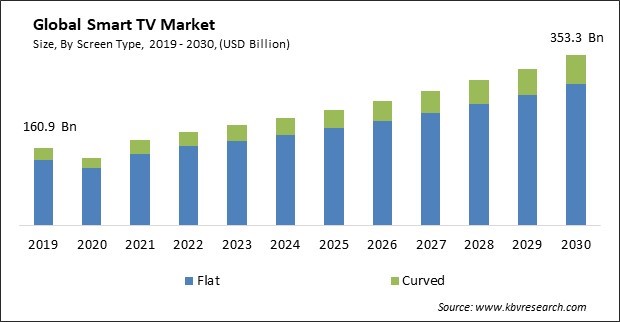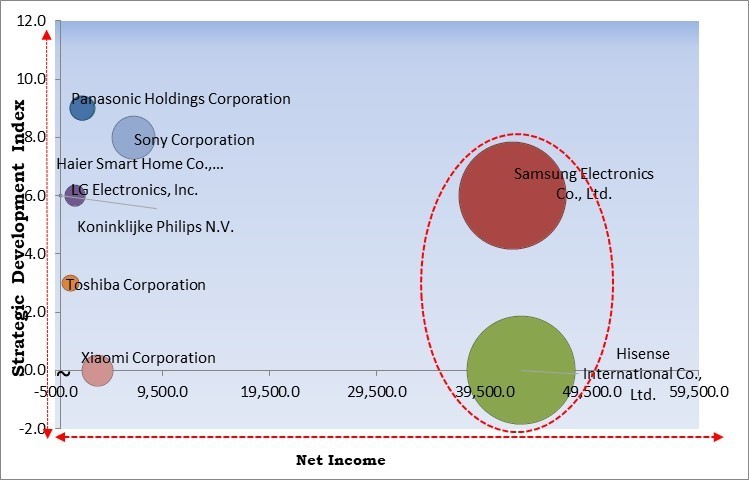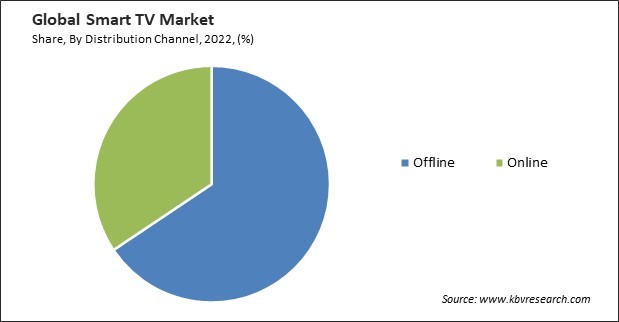The Global Smart TV Market size is expected to reach $353.3 billion by 2030, rising at a market growth of 7.8% CAGR during the forecast period. In the year 2022, the market attained a volume of 3,26,214.7 thousand units experiencing a growth of 8.0% (2019-2022).
Larger-sized smart TVs, particularly those above 65 inches, provide an immersive home theater experience. Consumers interested in replicating a cinematic experience at home opt for these larger screens, as they offer a more expansive and immersive viewing environment. Consequently, the above 65 inches segment would generate approximately 6.28% share of the market by 2030. Gamers often prefer larger screens for an immersive gaming experience. Smart TVs above 65 inches cater to gaming enthusiasts seeking a large console gaming display, offering a more engaging and immersive gaming environment.

The major strategies followed by the market participants are Product Launches as the key developmental strategy to keep pace with the changing demands of end users. For instance, In October, 2023, Haier Group Corporation a parent company of Haier Smart Home Co., Ltd. has unveiled the C11 OLED TV in India. This smart TV comes with features including 120Hz display, Dolby Vision IQ and 50W Harman Kardon speaker with two screen options 55-inch and 65-inch. In August, 2023, LG Electronics, Inc. has unveiled its inaugural wireless OLED TV, the 97-inch LG SIGNATURE OLED M (model 97M3). Currently accessible in South Korea, the 97M3 eliminates the need for cables, with the exception of the power cord. LG's wireless AV transmission solution streamlines cable management for users linking their TVs to devices such as gaming consoles and set-top boxes, providing a convenient and hassle-free experience.
Based on the Analysis presented in the KBV Cardinal matrix; Samsung Electronics Co., Ltd. and Hisense International Co., Ltd. are the forerunners in the Smart TV Market. In June, 2023, Samsung Electronics America, a branch of Samsung Electronics Co. Ltd., introduced its newest product, the 98Q80C model, a 98-inch Samsung QLED 4K TV. This Smart TV is engineered to provide exceptional picture quality, featuring Direct Full Array and Quantum HDR+ technology. The inclusion of the Samsung Neural Quantum Processor enhances its ability to upscale various content formats to impressive 4K resolution, regardless of their original source. and Companies such as Sony Corporation, Xiaomi Corporation, Haier Smart Home Co., Ltd are some of the key innovators in Market.

The features and applications of smart TVs surpass those of conventional televisions. Prominent contenders are devoting efforts to advancing their operating systems to contend with Apple and other streaming device producers. For example, WebOS by LG Electronics and Tizen by Samsung Electronics enable users to access online streaming applications and download software from the app store. Therefore, the market expansion is driven by the sophisticated features of smart TVs.
As a result of the expansion of the internet, products across diverse categories acquired internet access capabilities and exhibited entirely distinct values. The internet introduced the new digital home concept to everything from consumer goods to home entertainment products. In addition, the rise in prominence of audio and video entertainment sparked considerable debate regarding smart TVs. Therefore, internet connectivity is essential for the operation of smart TVs. Consequently, the expansion of high-speed internet is a significant contributor to the expansion of the market.
While effortless streaming is entertaining and convenient, it can harm the quality of the images. For example, a sluggish Wi-Fi signal causes a distorted television image. Additionally, internet bandwidth problems or a defective connection may result in display malfunctions for users. Even if users have fast Wi-Fi and every connection functions properly, specific TV settings may affect the resolution and result in a pixelated image. Most televisions include noise reduction, which diminishes the "snow" that degrades image quality. Thus, technical issues associated with smart TVs may impede market expansion.
On the basis of screen type, the market is bifurcated into curved and flat. In 2022, the curve screen segment attained a substantial revenue share in the market. The inspiration for the curved television originated from the slightly curved IMAX movie screen. Large wide screens that, in principle, are shaped like the human eye and thus provide greater immersion are available. Curved televisions offer a visual experience that gives depth and breadth, enhancing users' immersion in their viewing content. Curvature increases contrast, facilitating the visual distinction between black and white and screen edge sharpness.
By distribution channel, the market is bifurcated into offline and online. The offline segment acquired the highest revenue share in the market in 2022. The benefits of purchasing smart TVs from offline distribution channels include physically inspecting products for quality assessment. Immediate availability allows for instant possession without shipping delays. Moreover, expert advice from knowledgeable sales representatives’ aids in decision-making. Potential negotiation for pricing or additional items enhances value. Simplified processes for returns, exchanges, and warranty handling offer convenience. Local support ensures nearby assistance for installation and troubleshooting needs. Additionally, offline purchase minimizes the risk of shipping-related damages.

Based on resolution, the market is divided into HDTV, full HDTV, 4K UHD, and others. In 2022, the 4K UHD segment recorded a considerable revenue share in the market. The display resolution of 4K ultra-HD, or 4K or UHD, is around 4,000 pixels. This technology provides a resolution four times greater than the standard HD 1080p. Having a resolution of about 3840 by 2160, 4K televisions exhibit approximately 8 million pixels, thereby providing images with exceptional clarity and detail. It produces a more precise and detailed image, enhancing the viewing experience by making it more immersive. The growth of this segment is being propelled by consumers' demand for immersive experiences and images that are crystal clear and vibrant.
Based on the screen size, the market is classified into below 32 inches, 32 to 45 inches, 46 to 55 inches, 56 to 65 inches, and above 65 inches. The 46 to 55 inches segment procured the maximum revenue share in the market in 2022. The 46 to 55-inch range balances screen size and room compatibility, appealing to consumers seeking a larger viewing experience without overwhelming smaller spaces. It offers a comprehensive viewing experience for sports, movies, and gaming and is compatible with various living room and bedroom configurations. Many TVs in this size bracket offer high-resolution displays, such as full HD (1080p) or 4K ultra-HD, delivering crisp and detailed images. The demand for better picture quality, especially as streaming services offer more high-definition content, contributes to the popularity of these mid-sized smart TVs.
| Report Attribute | Details |
|---|---|
| Market size value in 2022 | USD 194.8 Billion |
| Market size forecast in 2030 | USD 353.3 Billion |
| Base Year | 2022 |
| Historical Period | 2019 to 2021 |
| Forecast Period | 2023 to 2030 |
| Revenue Growth Rate | CAGR of 7.8% from 2023 to 2030 |
| Number of Pages | 457 |
| Number of Table | 893 |
| Quantitative Data | Volume in Thousand Units, Revenue in USD Billion, and CAGR from 2019 to 2030 |
| Report coverage | Market Trends, Revenue Estimation and Forecast, Segmentation Analysis, Regional and Country Breakdown, Competitive Landscape, Porter’s 5 Forces Analysis, Company Profiling, Companies Strategic Developments, SWOT Analysis, Winning Imperatives |
| Segments covered | Screen Type, Distribution Channel, Resolution, Screen Size, Region |
| Country scope |
|
| Companies Included | Haier Smart Home Co., Ltd. (Haier Group Corporation), Xiaomi Corporation, LG Electronics, Inc. (LG Corporation), Panasonic Holdings Corporation, Samsung Electronics Co. Ltd. (Samsung Group), Sony Corporation, Toshiba Corporation, Hisense International Co., Ltd., Koninklijke Philips N.V., Intex Technologies. |
| Growth Drivers |
|
| Restraints |
|
Region-wise, the market is analyzed across North America, Europe, Asia Pacific, and LAMEA. The North America region generated a substantial revenue share in the market in 2022. Presently, the market in North America is influenced by many factors. The proliferation of high-speed internet has led to a substantial surge in online content consumption in recent years. Furthermore, the expanding electronics sector has been integrating many technological advancements, including artificial intelligence and voice control, into smart devices such as smart televisions, thereby stimulating demand.
Free Valuable Insights: Global Smart TV Market size to reach USD 353.3 Billion by 2030
The market research report covers the analysis of key stakeholders of the market. Key companies profiled in the report include Haier Smart Home Co., Ltd. (Haier Group Corporation), Xiaomi Corporation, LG Electronics, Inc. (LG Corporation), Panasonic Holdings Corporation, Samsung Electronics Co. Ltd. (Samsung Group), Sony Corporation, Toshiba Corporation, Hisense International Co., Ltd., Koninklijke Philips N.V., Intex Technologies.
By Screen Type (Volume, Thousand Units, USD Billion, 2019-2030)
By Distribution Channel (Volume, Thousand Units, USD Billion, 2019-2030)
By Resolution (Volume, Thousand Units, USD Billion, 2019-2030)
By Screen Size (Volume, Thousand Units, USD Billion, 2019-2030)
By Geography (Volume, Thousand Units, USD Billion, 2019-2030)
The Market size is projected to reach USD 353.3 billion by 2030.
Rising demand for advanced features in TVS are driving the Market in coming years, however, Technical issues associated with smart TVS restraints the growth of the Market.
Haier Smart Home Co., Ltd. (Haier Group Corporation), Xiaomi Corporation, LG Electronics, Inc. (LG Corporation), Panasonic Holdings Corporation, Samsung Electronics Co. Ltd. (Samsung Group), Sony Corporation, Toshiba Corporation, Hisense International Co., Ltd., Koninklijke Philips N.V., Intex Technologies.
In the year 2022, the market attained a volume of 3,26,214.7 thousand units experiencing a growth of 8.0% (2019-2022).
The HDTV segment is leading the Market by Resolution in 2022 thereby, achieving a market value of $161.2 billion by 2030.
The Asia Pacific region dominated the Market by Region in 2022, and thereby, achieving a market value of $136.1 billion by 2030, growing at a CAGR of 8.2 % during the forecast period.
Our team of dedicated experts can provide you with attractive expansion opportunities for your business.

